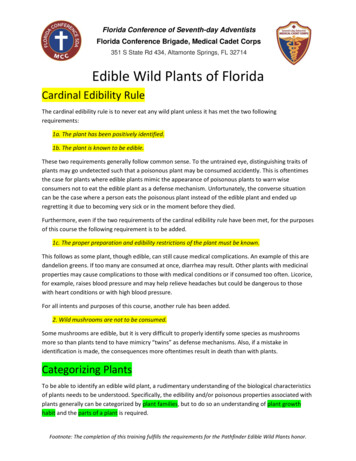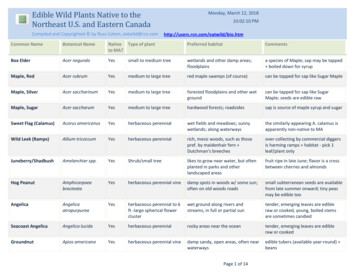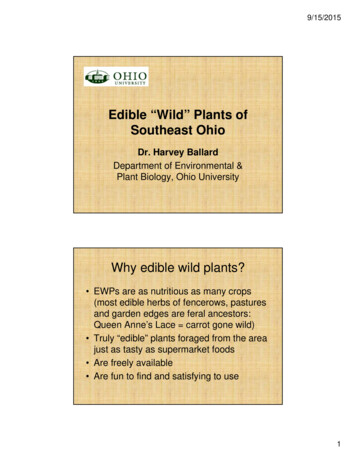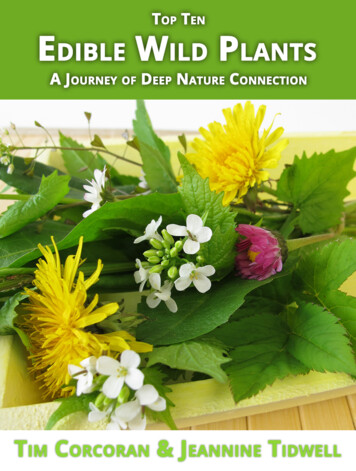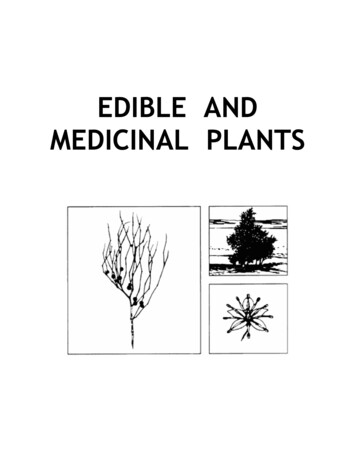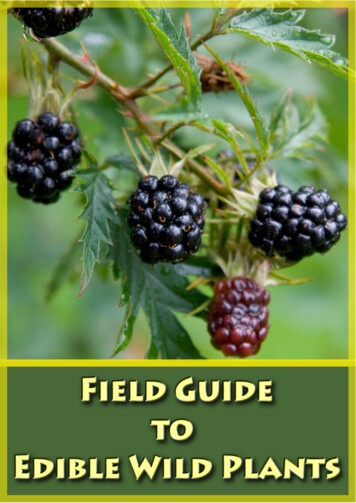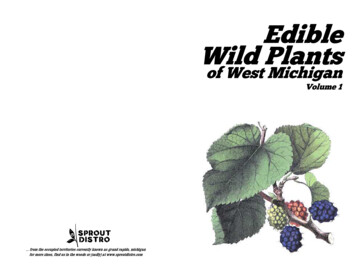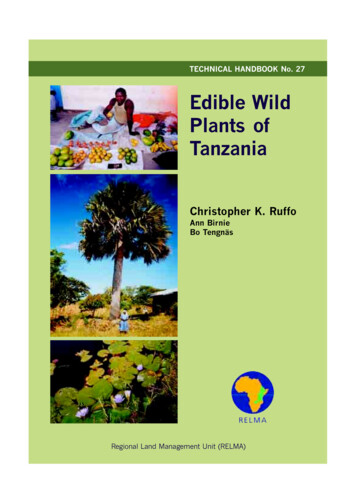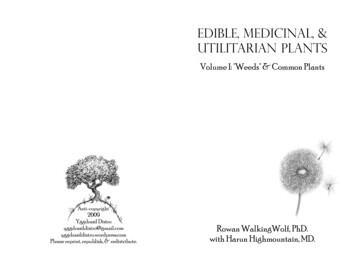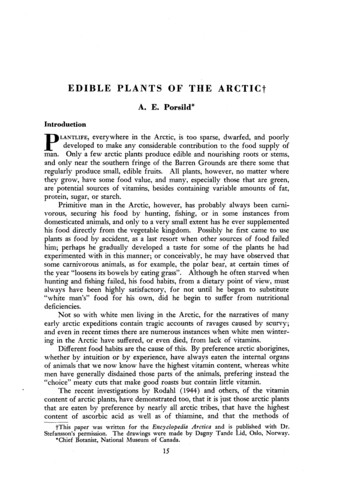
Transcription
E D I B L EP L A N T SO F T H EA R C T I C ?A. E. Porsild”IntroductionPeverywhere in the Arctic, is too sparse, dwarfed, and poorlydeveloped to make any considerable contribution to the food supply ofman. Only a few arctic plants produce edible and nourishing roots or stems,and only near the southern fringe of the Barren Grounds are there some thatregularly produce small, edible fruits. All plants, however, no matter wherethey grow, have some food value, and many, especially those that are green,are potential sources of vitamins, besides containing variable amounts of fat,protein, sugar, or starch.Primitive man intheArctic,however,has probably always been carnivorous, securing his food by hunting, fishing, orin some instances fromdomesticated animals, and only to a very small extent has lie ever supplementedhis food directly from the vegetable kingdom. Possiblyhe first came to useplants as food by accident, as a last resort when other sources of food failedhim; perhaps he gradually developed a taste for some of the plants he hadexperimented with in this manner; or conceivably, he may have observed thatsome carnivorous animals, as for example, the polar bear, a t certain times ofthe year “loosens its bowels by eating grass”. Although he often starved whenhunting and fishing failed, his food habits, from a dietary point of view, mustalways have been highlysatisfactory, fornotuntilhe began to substitute“white man’s’’ food for his own, did he begin to suffer from nutritionaldeficiencies.Not so with white men living in the Arctic, for the narratives of manyearly arctic expeditions contain tragic accounts of ravages caused by scurvy;and even in recent times there are numerous instances when white men wintering in the Arctic have suffered, or even died, from lack of vitamins.Different food habits are the cause of this. By preference arctic aborigines,whether by intuition or by experience, have always eaten the internal organsof animals that we now know have the highest vitamin content, whereas whitemen have generally disdained those parts of the animals, prefering instead the“choice” meaty cuts that make good roasts but contain little vitamin.The recent investigations by Rodahl (1944) and others, of the vitamincontent of arctic plants, have demonstrated too, that it is just those arctic plantsthat are eaten by preference by nearly all arctic tribes, that have the highestcontent of ascorbic acid as well asofthiamine, and thatthe methods ofLANTLIFE,tThis paper was writtenfortheEncyclopedia Arctica and is published with Dr.Stefansson’spermission. The drawings were made by Dagny Tande Lid, Oslo, Noway.*Chief Botanist, National Museum of Canada.15
16EDIBLE PLANTS OF THE ARCTICpreparation and of storing of vegetable foods used by these people are perhapsthe best possible in the circumstances for the preservation of vitamins.Although in the aggregate, the amount of vegetable food used by arcticaborigines has always been small, they have, nevertheless, made use of a largenumber of different species. One factor limiting the amount they coulduseis that most arctic plants are available for a very short time only each year,and that primitive man in the Arctic has never learned to cultivate any species;nor has he learned to take advantage of the fact thatmany arctic plants respondto manure, as can be easily observed by their abundance and luxuriance nearhuman habitation, bird cliffs, and animal burrows. This is perhaps not strangeconsidering that most of these people are nomadic, and that, among primitivepeoples, the gathering of roots and berries is the work of women and children.It is surprising that even the Chukchi, who make such extensive use of plants,have not learned to cultivate any species. Primitive man intheArctic has,however, learned togather and tostore plant foodforwinteruse, and toimprove the palatability of some species by cooking, and even, if perhaps nota t first intentionally, by a crude form of fermentation.Among the Eskimo-the most widely distributed race of arctic aboriginesthe dependence on vegetable food varies from group to group according totradition and according to whatplants are available in the area occupied bythem; thus, to the niost northerly tribes the useof vegetable food is purelyincidental and largely limited to the partly fermented and pre-digested contentof the rumen of caribou and muskoxen, whereas in the diet of the Eskimo ofsouthwesternGreenland,Labrador,andwesternand southwestern Alaska,vegetable food constitutes a regular, if not very large, item. In northeasternSiberia, Kjellman (1882) notedthat vegetable matterformedanimportantpart of the food of the Chukchi. “Although the flesh of reindeer, seal, walrus,and bear, besides blood, blubber, fish, and other animal food forms the bulkof their diet, it cannot be denied, and must not be overlooked, that not onlythe nomadic reindeer Chukchi but also thehunting tribes living along thesea coast, utilize and have a definite taste for vegetable food. When available,vegetable food constitutes a regular part of at least their principal meals, andis eaten eagerly, and certain kinds even with avidity; furthermore,theyconsider these foods important enough each year to gathersupplies that willlast them through the long, grim winter”.In the matter of providence the Chukchi differ from the Eskimo, to whomthe large scale gathering and storing of food is not a common or universalpractice. Kjellman related that the inhabitants of Pitlekaj and the surroundingaccumulatedChukchi villages, a t the beginning of thewinter of1878,hadstores of vegetables that were fully comparable with their stores of meat andblubber. So large, says Kjellman,were some of these stores thata reindeerChukchi, whom he visited in March, still had on hand considerable quantitiesof vegetables that had been gathered in the course of the preceding summerandautumn.The collection of such large quantities of vegetables wouldentail an amount of planning and perseverance which is, indeed, unusual amongarctic peoples.
PLANTSEDIBLEOF T H E ARCTIC17W. Bogoras (1904) who, first as a member of Sibiryakoffs party and laterof the Jesup North Pacific Expedition, spent many years among the Chukchi,has confirmed Kjellman’s observations on the food habits of the Chukchi, butfound that: “On the whole, vegetable food is much more used by women andchildren than by men” (p. 199).The rather extensive use which the Chukchi make of vegetable food doesnot seem to be conditioned by local abundance of edible plants or by the lackof animal food. In physiography, as well as in flora and fauna, the PoluostrovChukotski(Chukotsk Peninsula) is certainly comparable withnorthwesternAlaska whereplantfoodplays a far less important role in thediet of theEskimo. Kjellman thinks that the habit has been preserved from a time whentheChukchi lived farthersouth, in a climate moreproductive of vegetablematter.I t isofinterest to notethat,althoughnative plants have never beenextensively used by whites living in the Arctic, those eaten-mostly in emergencies-have generally been different species from those used by the aborigines,and, in the light of our present knowledge of vitamins, of lesser value. Thusthere are numerous examples in the narratives of arctic expeditions of the usesmade of lichens-especially “rocktripe”or “tripe-de-roche” of theearlyCanadian Voyageurs-besides mushrooms, puffballs, and scurvy grass (Cochlearia), none of which is ever eaten by aboriginal tribes. Likewise, berries suchas the mountain cranberry or cowberry ( Vaccinium Vitis-ldaea), bilberry orwhortleberry (Vacciniumuliginosum), and to a lesser extent baked-apple(Rubus Chamamorus) are perhaps amongthe most frequently and mostreadily used vegetable foods of white men living in the Arctic, whereas thesefruits are generally ignored by aboriginal peoples who prefer the crowberry(Empetrum) which, in turn, is not favoured by whites.The use andpreparationof arctic food plantsGenerally speaking notrulyarcticplant is poisonous, nor are thereknown to be poisonous mushrooms, roots, or berries anywherebeyondthelimit of trees, where, in fact, it is safe to eat any vegetable producethatappears at all edible. In the northern forest,ontheotherhand, there are afew plants thatare definitely known to be poisonous. Those chiefly to beon guard against are the roots of water hemlock or musquash root, Fig. 7d,(Cicuta spp.), the fruits of red baneberry, Fig. 7a, b, c, (Actaea rubra), thedeath-cup toadstool (Amanita phalloides),and the almost equally poisonous flyamanita (Amanita muscaria). The latter, however, is in great demand amongtheChukchi and otherarctic tribes of eastern Siberia whochewthedriedfungus as a narcotic or intoxicant (Bogoras, 1904).At first glance, it might appear that the arctic aboriginal races use anyplant, orany part of a plantthat happens to beavailable, and is nottoounpalatable. Such a conclusion, however, would be entirely erroneous. Thus,certaincircumpolar species of plants are used by nearly all arctic tribes,
18EDIBLE PLANTS OF T H E ARCTICwhereas other, and closely related ones, are not. Furthermore, an examinationof the long list of plants used by Eskimo and Chukchi, shows that the preference for certain species is not dictated by local abundance. Kjellman ( 1882),for example, foundthat one of the principal food plants of theChukchiwas a certain willow, which was very common near the winter quarters of theVega and supplied thebulk of the vegetab efood collected. Other, andequally palatable plants, that to all intent and purpose were just as commonand could have been collected without effo and in equal quantity,werecompletelyignored. In this connection it isof interestthatRodahl(1944)found that the ascorbic acid content of the le ves and buds of arctic willowsexceed that of all other arctic plants examined by him.Some plants, on the other hand, that were far less common and, on accountof their scarcity and small size, had relatively small food value, were collectedwith an eagerness and perseverance that, in view of the general indolence ofthese people, astounded Kjellman. One such plant is Polygonumviuiparum,which, according to the Chukchi must be colle ted immediately after the snowleaves the ground and before the first leaves appear. Only the rhizome, whichisof the size of an unshelled peanut, is used; but to find and collect it in earlyspring certainly is no easy task. Nevertheless, even full-grown people, according to Kjellman, engaged in the collecting, and with surprisingly good results.Kjellman noted thatthefloweringstems of themuchless common,Rhodiola rosea, and especially theroottubers of thevetch,Hedysammobscurum, were also considered choice and muchfavoured delicacies. Asregards preparation of vegetable food, he found that only a few plants wereconsumed raw;the bulk were eaten boiled lin soup cooked with meat orblood, and oftenafter first having been made into a form of “sauerkraut”.Roots, leaves, and stems of plants collected for winter use weretightlypacked into sealskinbags, as arule each kind by itself. Inthe process ofstoringsuch plants underwent some sort of fermentation. By theirtexture,smell, and taste Kjellman was able to recognize several kinds of “sauerkraut”.One of them consisted entirely of the small twigs and leaves of Salix kolymensis; a second was composed largely oftjheleaves of Petasites frigidus,mixed with a variable quantity of leaves of Skrxifraga punctata, leafy twigs ofSalix kolymensis, the flowering axes of Seneci congestus, and leaves of Oxyriadigyna; while a third consisted entirely of the succulent green leaves and stemsof theknotweed, Polygonum alaskanum ( P . olymorphus). Otherforms of“sauerkraut”werepreparedfromtheflowe ing stems of several species offernweed (Pedicularis spp.) and from the le fy stems of seabeach sandwort(Arenaria peploides).Although several kinds of berries grew in the region and wereknownto theChukchi by name, Kjellman found that none was used to anygreatextent and thatonlycrowberries(Empetrum) were eaten occasionally.Among Eskimo the amount of plant food used varies from group to groupbutnowhere assumes theimportanceascribed to i t by Kjellman for theChukchi. Thus Weyer (1932) estimated that in the diet of the Eskimo ofthe Bering.Sea region vegetable foodconstituted no morethan 5 percent;fL1
PLANTSEDIBLEOF THE ARCTIC19amongtheCentralCanadian Eskimo Stefansson (1914) and Jenness (1928)notedthatit was scarcely used a t all; in Greenlandthepartplayed byvegetable food has always been unimportant, except from a dietary point ofview.Probably, in any particular group, the greatest use of plant food is todaymade by those who make the least use of imported “white man’s’’ food; thosewho have easy access to trading posts very soon give up the practice of gathering native plant food and use increasing amounts of imported plant food in theform of flour, sugar, fats, preserved fruits, and jams. Amongthemoresophisticated Canadian Eskimo and Indians it is not uncommon to find anapologetic attitude, or even a certain amount of condescension, toward the less“enlightened” and “backward” among theircountrymenwhostill maintain“native” customs and habits. Some years ago, while waiting for the arrival ofthe mail aircraft a t a trading post on the lower Mackenzie River, I noted alarge patch of wild raspberries “loaded” with excellent and fully ripe fruit.A group of native children were playing “hide and seek” among the raspberrycanes but did not appear to pick the fruit. When commenting on this to themother of one of the children-Iwas told that “she bought raspberry jam for herchildren in the store, where there was lots”.In the use and preparation of plantfood, Eskimo practices differonlyslightly from those of the Chukchi, the chief difference being, perhaps, thatmore extensive use is made of berries, and that such roots, stems, and leaves ofplants as are used, are not infrequently stored mixed with blubber. Althoughoil from the blubber may to some extent act as a preservative, some fermentationundoubtedly takes place as withthe“sauerkraut”preparedby theChukchi. Twenty-five years ago, I found that only a small number of plantswas used by the Eskimo of northwestern Alaska. Among the more importantwere the leaves of Saxifraga punctata, the leaves and flowering axes of marshfleabane (Seneciocongestus) and coltsfoot (Petasitesfrigiqys), all of whichwere made into a form of “sauerkraut” mixed with blubber; the root tubersof Eskimo potato (Claytoniatuberosa) and those of thevetch (Hedysaruvzalpinum) were gathered in considerable quantities and used during the wintercooked as a vegetable with meat. Of the several kinds of berries used, cloudberry or baked-apple (Rubus Chamamorus)and crowberry (Empetrum) werethe most favoured. Both were eaten fresh or preserved frozen in sealskin bags.a few native plants are regularly eatenIn modern west Greenland onlyby the Greenlanders as seasonaldelicacies, but from a dietary point of viewtheymay, nevertheless, be of considerable importance. The more primitiveeast Greenlanders, on the other hand, make considerable use of plant food.In thesouthernpartsof east and westGreenlandthekvan(AngelicaArchangelica) is common along brooks, and in sheltered spots in thefiordsmay grow to a height of 6 feet. The tender, young leaf-stalks and floweringstems are considered a great delicacy and, when available, are eaten raw ingreat quantities. Because the kvan does notgrow near the open sea coast,where most Greenlandtownsand villages are situated, and because thisvegetable is in suchgreat demand, longjourneysareregularlyundertaken
20EDIBLE PLANTS OF THEIRCTICby the Greenlanders to obtain it. The kvan is equally relished by the Danishresidents who generally eat it cooked and creamed.Incidentally, the frequency with which the word kuaneq occurs in Eskimoplace names antedating the present colonization of Greenland, shows that theEskimo borrowedtheScandinavian word k an fromthe language of themedieval Norse settlers of Greenland. Sinc the ancestors of the presentGreenland Eskimo arrived in Greenland after he Norse, they could have hadno previous knowledge of the kvan, and clea y adopted both the word andthe eating of this plant from the Norse.This isof particular interest becauseit shows that some, a t any rate, of the earlyorse-Eskimo contacts were nothostile.Of importance equal to that of the kvan is the crowberry (Empetrum),which is common everywhere in Greenland where it fruits abundantly at leastto latitude70"N.In 1857 Rink estimated thatmorethan 1,000 barrels wereconsumed annually insouthwestGreenlandby the 6,100 Eskimo, and thatduring the autumn months, when the berries were ripe, they formed a regularpart of the Greenlander's diet. The berries areeithereaten fresh, whenpicked, or served withfresh and uncooked seal blubber. They keep wellwhen frozen and in this state may be stored throughout the winter. In placeswhere Empetrum is common, they may even be gatheredunderthesnow.The frozen berries are scooped with a special scraperintoa sieve made ofsealskin, through which the snow, leaves, and other impurities are sifted.The flowering stems of roseroot (Rhodiola rosea) and the fernweeds,Pedicularis hirsuta and P. lunata, find a limited use as potherbs. The mountaincranberry or cowberry (Vaccinium Vitis-Zdaea) is of local occurrence inGreenland whereas thebilberry (Vacciniud uliginosum) has adistributionsimilar to that of the crowberry. While notfavouredbytheGreenlanders,bothare in great demand by Danish residents. Several species of seaweedare eaten by Greenlanders and have recently been found to bean importantsource of ascorbic acid.The fermented and half-digested content of caribou rumen, and also thatof the muskox is considered a delicacy by all ,Eskimo who hunt these animals.This vegetable food is eaten raw or added to soup made from meat or blood.It is frequently preserved frozen for winter us . According to Bogoras (1904)thecontent of the reindeer rumen is eaten by theChukchi and byotherreindeer nomads of northeasternSibena.nGreenland,whereptarmiganare hunted extensively for sale to Danish res' ents, the content of the crop isusually eaten a t once by the hunter.In the light of Rodahl's findings (1945) that the arctic willow and groundbirch,both in summer and in winter,are r1 h sources of ascorbic acid, andthat the latter alsois an important source f thiamine, the dietary value ofthecontent of both caribou rumen and ptarmigan crop is probably high.Although the bulk of the winter food of caribou and reindeer is lichen, twigsof willow and groundbirchformanotinconsiderable addition, and theseplants, summer and winter, are the principal source of food for both muskoxenand ptarmigan.416
21EDIBLE PLANTS OF THE rriesIn late summer several kinds of small fruits may be found in abundance,exception thoseespecially near thesouthernfringe of theArctic.Withoutfound north of the limit of trees are edible and wholesome. Several kinds arenot damaged, and many even be improved in flavour, by freezing. Some maybe collected under the snow, or when the snow disappears in spring. In orderof abundance and palatability the more important are as follows:BlackCrowberryorCurlewberry.Empetrum nigrum. Fig. Ih.Depressedand matted, freely branching, evergreen shrub. Leaves linear,spreading, resembling those of spruce or juniper. The flowers are inconspicuous and solitary in the axils. The purplish black and shinyfruits are veryjuicy and sweet but contain a number of large hard seeds.The crowberry is circumpolar and is found throughout the arctic regions,in eastern North America south to mountains of the New England States, inthe west, southto California. It prefers sandy, rocky, andacidsoilsandreaches its perfection in a rather moist climate.Because of its abundance andhardiness, the crowberry or curlewberry,although not as well-flavoured as some other berries, iseasilythe mostimportant fruit of the arctic regions, and, apart from the cloudberry or bakedapple, is the only one regularly eaten by the natives of the Arctic. The berriesare eaten whenpicked or stored frozen and eaten with seal blubber or oil.According to Rink (1857) a sparkling whitewinemaybeproducedbyfermentation of the juice.Cloudberry,Salmonberry,orBaked-Apple.Rubus Chamaemorus. Fig. li.Herbaceous,low perennial from a creepingrootstock. Leaves round orkidney-shaped, five- to nine-lobed, stalked. Flowers solitary, terminal ’/2 to1 inch broad, and white. The immaturefruits are first reddish, then amber,and when fully ripe become pale yellow and very juicy. Sir John Richardson(1851, p. 293) aptly described them: “perhaps the most delicious of the arcticberries when in perfection, but cloys if eaten in quantity” ‘whereasFernald andKinsey (1943, p. 236) praised them with less reserve saying: “The ripe, freshberries of Baked-Apple eaten without sugar or cream are delicious, but withthe addition of thesedressings are positively luscious”. The Eskimo, lackingsuch refinements, serve them in a mixture of seal oil and chewed caribou tallowwhich has beenbeaten to the consistency of whippedcream. This culinarytreat in Alaskais known as “Eskimo ice cream”.BilberryorWhortleberry.Vaccinium uliginosum. Fig. 18.Low, branching, erect,ordecumbentshrubwithsmalloval, deciduousleaves. Flowers small, urn-shaped, pale pink, inthe leaf-axils.Berries,blueto black with a bloom, ripen early in August.The bilberry is common throughout all arctic countries and, inthesouthern part of the Arctic usually produces an abundance of sweet, delicious
22EDIBLE PLANTS OF THEFig. 1. Fruits and berries.a,Northern red currant (Ribes triste); b, c, Alpine bearberry(Arctostaphylosalpina); d, Redbearberry ( A . rubra); e, Bearberry ( A . Uva-Ursi); f,Mountain cranberry (Vaccinium V’itis-ldaea); g, Bilberry ( V . uliginosum) ; h, Black crowberry (Empetrum n i g m ) ; i, Baked-apple or cloud erry (Rabus Chmnaemorus). X 2/5.1berries. It grows in acid soil in open places, nd inhabits dry as well as moistplaces.Although to the Europeanpalate of bette flavour than the crowberry, thebilberry is not much esteemed by Eskimohobelieve it is liable to causedental decay.Lingon, Mountain Cranberry, or Cowberry. Vacca’niumVitis-Zdaea. Fig. If.Low, creeping shrub with dark, leathery evergreen leaves. Flowers bellshaped, whiteor pink, in small, nodding,ter inal clusters. The shiny, darkred berries ripen in August and September, bu remain on the vines throughoutt e snow disappears, are sweeter,the winter, and the following spring, whenand even better than in the autumn.The mountain cranberry is widely distrib ted throughout arctic countriesoccurring north at least to the arctic coast, ut does not, as a rule, produceberries far north of the tree-line. It prefers acid soil and is found in moist aswell as in dry,rocky places. It reaches its perfection, however,inopenbirch or willow thickets, wherein some years the vines may be redwiththe fruit.When gathered in the autumn the tart berries, if frozen, will keep untilnext spring. They are consideredbetter flavoured thanthesoutherntrueI
PLANTSEDIBLEOF T H E ARCTIC23cranberry, and are excellent for jamsandjellies,A very refreshing beveragemay be made from the diluted, sweetened juice.Alpine and Red Bearberry. Arctostaphylos alpina and A. rubra. Fig. lb,c,d.Low, trailing shrubs with shreddy bark, and deciduous, obovate or oblanceolate, and finely serrated leaves. The flowers are small and appear in clusterstoward the end of the branches in early spring before the leaves unfold. InA. alpina the berries are black and shiny; in A. rubra they are red, juicy butrather watery andinsipid. Although eaten greedily by bears and ptarmigan,the berries are unattractiveto most people, but,accordingtoFernaldandKinsey (1943, p. 3 10) : “in the absence of more attractive berries this fruit isapparently wholesome and onesoon acquires a taste for it”.BearberryorKinnikinik. ArctostaphylosUva-Ursi.Fig. le.Trailing evergreen shrub with small, bell-shaped, pink flowers in nodding,terminal clusters. The coral-red and somewhatmealy and dry berries arerather tasteless when raw, but quite palatable whencooked. The powdereddry leaves are occasionally used by natives as a substitute for tobacco, or mixedwith it.Northern Red Currant. Ribes triste. Fig. la.The northernredcurrantoccurs throughoutthewoodedparts of theArctic but only extends a short distance into the Barren Grounds. The berriesare almost indistinguishable from cultivated red currants in flavour andappearance; they ripen in August but last only a short time.PotherbsThe leaves and flowering stems of a large number of arctic plants may beused in soups, as potherbs, pickled as “sauerkraut”, or in salads. Descriptions,together with brief notes on their occurrences and uses, are given below.WoollyFernweed or Louse-wort. Pedicularis lunata. Fig. 2b,c.Perennial herb with a well-developed tap root terminating in one or moredense rosettes of pinnately lobed leaves, that resemble the fronds of certainferns; the leafy, 5- to 10-inch high flowering stem terminates in a dense, white,woolly spike of rose-pink, scented flowers. Towardmaturitythestemselongate, and in winter often protrude through the snow.The root, whichis lemon yellow and sweet, like young carrot, may be eaten raw or cooked;the floweiing stem may be eaten boiled as a potherb. Eskimo children pickthe flowers and suck the sweet nectar from the base of the long corolla tube.The woolly fernweed is one of the earliest spring flowers on the arctictundra. It is circumpolarand of arctic range.ArcticFernweed.Pedicularis arctica. Fig. 2a.Similar, but with less woolly and more open spikes of pale, pink flowers.The root ispale yellowandmorespindly. Pedicularis arctica is a NorthAmerican species which ranges fromnorthwesternGreenlandto the northcoast ofAlaska.
24EDIBLE PLANTS OF THE ARCTICFig. 2. Potherbs. a, Arcticfernweed (Pedicularisarctica); b, c,Woolly fernweed ( p .lmata) ; d, Hairy fernweed (P.hirsuta); e, P.sudetica; f, Marsh-fleabane (Senecio congestus) ; g, Round-leavedsaxifrage (Saxifragapunctata) . X 21s.HairyFernweed.Pedicularishirsuta.Fig. 2d.Similar, with still paler flowers in a shorter spike. Liketheprecedingspecies, thehairyfernweedisof arctic or high arctic range, but limited towestern Asia, Europe, Greenland, and the Eastkrn Canadian Arctic.LFernweed. Pedicularissudetica.Fig. 2e.Circumpolar, glabrous perennial with ark-coloured leaves and stems,from a slender, freelybranchedrootstock.he flowers aredarkred,inadense spike which elongates as the seeds mature.According to Kjellman theChukchipreparea “sauerkraut”fromtheflowering stems and eat the boiled rootstocks in soup.IIMountainSorrel.Oxyriadigyna.Fig. 3d.Low and glabrous, somewhat fleshy pe ennial witherect, simple stemsfroma large, chaffyrootstock.Leaves are mostly basal, kidney-shaped inoutline with from 1- to 2-inch wide blades n long, slender stalks. Flowerssmall, red or green, in a terminal plume-like r ceme.The mountain sorrel is acircumpolar, arctic-alpine species, ranging onthe Barren Grounds from the north tip of Ellesmere Island south to the limitof trees, and in high mountains even south into California. It prefers somewhat shaded slopes and ravines, wheresnow accumulates during the winterand provides moisture that lasts throughout the growing season. In such placesthefreshgreen leaves of themountainsorrel may be found all summer. Itf
EDIBLE PLANTS OF THE ARCTIC25Fig. 3. Potherbs. a,Broad-leaved willow-herb (Epilobiznn latifolium) ; b, Northern sweetcoltsfoot (Petusites frigidus); c, Roseroot (Rhodiolu rosea) ; d, Mountain sorrel (Oxyriudigynu). X 2/5.responds wonderfully to manure, and in the rich soil under bird cliffs and nearEskimo dwellings may form large luxurious beds.The succulent, juicy leaves and young stems are edible. When raw theyare somewhat acid, but most refreshing and thirst-quenching; whencookedtheir flavour andappearance resembles spinach. InGreenland a verytastydish, not unlike stewed rhubarb, is prepared from the sweetened juice thickened with a small amount of rice- or potato-flour.The Eskimo of Greenland and Alaska eat the fresh leaves of the mountainsorrel, mixed with seal blubber.Broad-leaved Willow-herb. Epilobium latifolium. Fig. 3a.Erect, glabrous, simple or branching perennial herb from 6 to 18 incheshigh, with lanceolate, dark green and somewhat glaucous, sessile,andfleshyleaves. The flowers are purple, very large and showy, in leafy racemes. Thelong and narrow seed pods contain fourrows of seeds bearing long, silky,tufts of white hairs at Aeir summits.The willow-herb is circumpolar in range and is common and even abundantthroughout the Arctic onsandy or gravelly, well watered soils such as arefound on gravel bars in rivers and on flood plains.The flowers-the largest in the Arctic-may be eaten raw as a salad; thefleshy leaves are edible when cooked and in taste resemble spinach. In Greenland thefresh leaves andthe flowers are occasionally eaten rawwith sealblubber.
26EDIBLE PLANTS OF THEiiCTICEskimoRhubarb.Polygonum alaskanum (P.alpinum v. lapatbifolium) .Fig. 4b.Freely branching perennial herb from a s out, fleshy rootstock severalinches thick, bearing leafy stems from 3 to 6 fee high. The stems are reddishwith thickened, sheath-covered joints from wh h rise the 2- to 8-inch longlanceolate-attenuate leaves. The flowers are mall and greenish, in large,plumose axillary panicles.Eskimo rhubarb is common in eastern sia,Alaska,the Yukon, andeast to the Mackenzie and extends north slightly beyond the limit of trees. Itprefers moist, alluvial or open soil such as is fopnd along river banks, and onfresh landslides in the permafrost area it may form purestands several acresin extent.The young, finger-thick, brightred, and juicy stems appear soon afterthe snow melts; in flavour they resemble rhubarb and may be used a
EDIBLE PLANTS OF THE ARCTIC? A. E. Porsild" Introduction P LANTLIFE, everywhere in the Arctic, is too sparse, dwarfed, and poorly developed to make any considerable contribution to the food supply of man. Only a few arctic plants produce edible and nourishing roots or stems,

